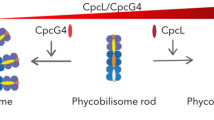Abstract.
The assembly, organization and function of the photosynthetic apparatus was investigated in the wild type and a chlorophyll (Chl) b-less mutant of the unicellular green alga Chlamydomonas reinhardtii, generated via DNA insertional mutagenesis. Comparative analyses were undertaken with cells grown photoheterotrophically (acetate), photomixotrophically (acetate and HCO− 3) or photoautotrophically (HCO− 3). It is shown that lack of Chl b diminished the photosystem-II (PSII) functional Chl antenna size from 320 Chl (a and b) to about 95 Chl a molecules. However, the functional Chl antenna size of PSI remained fairly constant at about 290 Chl molecules, independent of the presence of Chl b. Western blot and kinetic analyses suggested the presence of inner subunits of the Chl a-b light-harvesting complex of PSII (LHCII) and the entire complement of the Chl a-b light-harvesting complex of PSI (LHCI) in the mutant. It is concluded that Chl a can replace Chl b in the inner subunits of the LHCII and in the entire complement of the LHCI. Growth of cells on acetate as the sole carbon source imposes limitations in the photon-use efficiency and capacity of photosynthesis. These are manifested as a lower quantum yield and lower light-saturated rate of photosynthesis, and as lower variable to maximal (Fv/Fmax) chlorophyll fluorescence yield ratios. This adverse effect probably originates because acetate shifts the oxidation-reduction state of the plastoquinone pool, and also because it causes a decrease in the amount and/or activity of Rubisco in the chloroplast. Such limitations are fully alleviated upon inclusion of an inorganic carbon source (e.g. bicarbonate) in the cell growth medium. Further, the work provides evidence to show that transformation of green algae can be used as a tool by which to generate mutants exhibiting a permanently truncated Chl antenna size and a higher (per Chl) photosynthetic productivity of the cells.
Similar content being viewed by others
Author information
Authors and Affiliations
Additional information
Received: 10 November 1999 / Accepted: 22 December 1999
Rights and permissions
About this article
Cite this article
Polle, J., Benemann, J., Tanaka, A. et al. Photosynthetic apparatus organization and function in the wild type and a chlorophyll b-less mutant of Chlamydomonas reinhardtii. Dependence on carbon source. Planta 211, 335–344 (2000). https://doi.org/10.1007/s004250000279
Issue Date:
DOI: https://doi.org/10.1007/s004250000279




